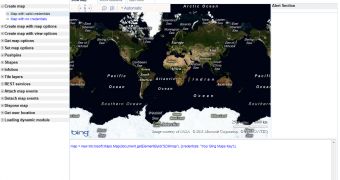Microsoft just kicked up a notch the resources available to developers building projects designed to integrate Bing Maps with the release of the Bing Maps AJAX Control 7.0 Interactive SDK. This new interactive software development kit for AJAX Control 7.0 is designed to be leveraged in conjunction with the Bing Maps AJAX Control 7.0 SDK / Bing Maps AJAX Control 7.0 application programming interface (API).
What’s great about the Bing Maps AJAX Control 7.0 ISDK is that devs can now easily access a range of code samples, as well as feature examples created around scenarios involving the integration of Bing Maps into third-party web applications.
The new Bing Maps AJAX Control 7.0 ISDK provides a great demo environment where developers can explore the features available to them, as well as easily access the code and events associated with them.
Of course, the resources shared by the software giant, including code samples can be reused in apps by third party devs.
The major features available in the Bing Maps AJAX Control 7.0 SDK are listed on the left hand side navigation pane. Bing Maps AJAX Control 7.0 ISDK provides demonstrations of the feature in action, allows developers to copy and edit the source code, and even alerts them when errors are identified.
A member of the Bing Maps team put together a small guide designed to let developers get started with the Bing Maps AJAX Control 7.0 ISDK:
“- Create map with map options > Map with inertia intensity: Try varying the inertiaIntensity parameter in the source code window. Set it anywhere between 0 and 1, hit run, and then see what happens when you click and drag the map.
-Create map with map options > Map with background color: Pull the fully zoomed out map down to see the background color and hit the "Run" button. This shows off the new backgroundColor option and gives you a random color every time. Try typing in your own RGB values and see what you get.
- Get user location > Get location: If the browser on your phone or PC supports the W3C GeoLocation API, then try out the new getCurrentPosition method to easily find yourself on the map. (Note that the accuracy of this function varies depending on the capabilities of the requesting client. For example, desktop users may see lower accuracy while mobile users see much higher.)
- Loading dynamic module > Load module - clustering: This shows you how you can use the new module loading methods to register and load your own custom modules (or modules built by other Bing Maps developers).”

 14 DAY TRIAL //
14 DAY TRIAL //